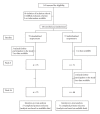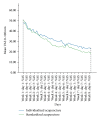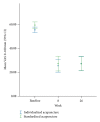Standardized versus Individualized Acupuncture for Chronic Low Back Pain: A Randomized Controlled Trial - PubMed (original) (raw)
Standardized versus Individualized Acupuncture for Chronic Low Back Pain: A Randomized Controlled Trial
Daniel Pach et al. Evid Based Complement Alternat Med. 2013.
Abstract
We aimed to compare the effectiveness of standardized and individualized acupuncture treatment in patients with chronic low back pain. A single-center randomized controlled single-blind trial was performed in a general medical practice in Germany run by a Chinese-born medical doctor trained in western and Chinese medicine. One hundred and fifty outpatients with chronic low back pain were randomly allocated to two groups (78 standardized and 72 individualized acupuncture). Patients received either standardized acupuncture or individualized acupuncture. Treatment encompassed between 10 and 15 treatments based on individual symptoms with two treatments per week. The main outcome measure was the area under the curve (AUC) summarizing eight weeks of daily rated pain severity measured with a visual analogue scale (0 mm = no pain, 100 mm = worst imaginable pain). No significant differences between groups were observed for the AUC (individualized acupuncture mean: 1768.7 (95% CI, 1460.4; 2077.1); standardized acupuncture 1482.9 (1177.2; 1788.7); group difference, 285.8 (-33.9; 605.5) P = 0.080). In this single-center trial, individualized acupuncture was not superior to standardized acupuncture for patients suffering from chronic pain. As a next step, a multicenter noninferiority study should be performed to investigate whether standardised acupuncture treatment for chronic low back pain might be applicable in a broader usual care setting. This trial is registered with ClinicalTrials.gov NCT00758017.
Figures
Figure 1
Recruitment, treatment, and follow-up of patients with chronic low back pain.
Figure 2
Mean symptom severity VAS of daily data over 8 weeks, nonadjusted data. Dashed lines represent the borders of the area under the curve.
Figure 3
Mean (with 95% confidence interval) pain intensity over the last 7 days (VAS) at week 8 and at week 26, nonadjusted data. At baseline, VAS was different between both groups (0.014), but not for the latter time points.
Similar articles
- Acupuncture for chronic low back pain: a multicenter, randomized, patient-assessor blind, sham-controlled clinical trial.
Cho YJ, Song YK, Cha YY, Shin BC, Shin IH, Park HJ, Lee HS, Kim KW, Cho JH, Chung WS, Lee JH, Song MY. Cho YJ, et al. Spine (Phila Pa 1976). 2013 Apr 1;38(7):549-57. doi: 10.1097/BRS.0b013e318275e601. Spine (Phila Pa 1976). 2013. PMID: 23026870 Clinical Trial. - Effectiveness of Electroacupuncture or Auricular Acupuncture vs Usual Care for Chronic Musculoskeletal Pain Among Cancer Survivors: The PEACE Randomized Clinical Trial.
Mao JJ, Liou KT, Baser RE, Bao T, Panageas KS, Romero SAD, Li QS, Gallagher RM, Kantoff PW. Mao JJ, et al. JAMA Oncol. 2021 May 1;7(5):720-727. doi: 10.1001/jamaoncol.2021.0310. JAMA Oncol. 2021. PMID: 33734288 Free PMC article. Clinical Trial. - Efficacy of acupuncture for chronic low back pain: protocol for a randomized controlled trial.
Cherkin DC, Sherman KJ, Hogeboom CJ, Erro JH, Barlow WE, Deyo RA, Avins AL. Cherkin DC, et al. Trials. 2008 Feb 28;9:10. doi: 10.1186/1745-6215-9-10. Trials. 2008. PMID: 18307808 Free PMC article. - Complementary and alternative therapies for back pain II.
Furlan AD, Yazdi F, Tsertsvadze A, Gross A, Van Tulder M, Santaguida L, Cherkin D, Gagnier J, Ammendolia C, Ansari MT, Ostermann T, Dryden T, Doucette S, Skidmore B, Daniel R, Tsouros S, Weeks L, Galipeau J. Furlan AD, et al. Evid Rep Technol Assess (Full Rep). 2010 Oct;(194):1-764. Evid Rep Technol Assess (Full Rep). 2010. PMID: 23126534 Free PMC article. Review. - Interventions for preventing and treating pelvic and back pain in pregnancy.
Pennick V, Liddle SD. Pennick V, et al. Cochrane Database Syst Rev. 2013 Aug 1;(8):CD001139. doi: 10.1002/14651858.CD001139.pub3. Cochrane Database Syst Rev. 2013. PMID: 23904227 Updated. Review.
Cited by
- Integrating complementary/alternative medicine into primary care: evaluating the evidence and appropriate implementation.
Wainapel SF, Rand S, Fishman LM, Halstead-Kenny J. Wainapel SF, et al. Int J Gen Med. 2015 Dec 7;8:361-72. doi: 10.2147/IJGM.S66290. eCollection 2015. Int J Gen Med. 2015. PMID: 26673479 Free PMC article. Review. - Efficacy of Acupuncture versus Combined Oral Contraceptive Pill in Treatment of Moderate-to-Severe Dysmenorrhea: A Randomized Controlled Trial.
Sriprasert I, Suerungruang S, Athilarp P, Matanasarawoot A, Teekachunhatean S. Sriprasert I, et al. Evid Based Complement Alternat Med. 2015;2015:735690. doi: 10.1155/2015/735690. Epub 2015 Aug 4. Evid Based Complement Alternat Med. 2015. PMID: 26346199 Free PMC article. - A Comprehensive Review of Alternative Therapies for the Management of Chronic Pain Patients: Acupuncture, Tai Chi, Osteopathic Manipulative Medicine, and Chiropractic Care.
Urits I, Schwartz RH, Orhurhu V, Maganty NV, Reilly BT, Patel PM, Wie C, Kaye AD, Mancuso KF, Kaye AJ, Viswanath O. Urits I, et al. Adv Ther. 2021 Jan;38(1):76-89. doi: 10.1007/s12325-020-01554-0. Epub 2020 Nov 12. Adv Ther. 2021. PMID: 33184777 Free PMC article. Review. - How to design high quality acupuncture trials-a consensus informed by evidence.
Zhang YQ, Jiao RM, Witt CM, Lao L, Liu JP, Thabane L, Sherman KJ, Cummings M, Richards DP, Kim EA, Kim TH, Lee MS, Wechsler ME, Brinkhaus B, Mao JJ, Smith CA, Gang WJ, Liu BY, Liu ZS, Liu Y, Zheng H, Wu JN, Carrasco-Labra A, Bhandari M, Devereaux PJ, Jing XH, Guyatt G. Zhang YQ, et al. BMJ. 2022 Mar 30;376:e067476. doi: 10.1136/bmj-2021-067476. BMJ. 2022. PMID: 35354583 Free PMC article. - Deep autoencoder-powered pattern identification of sleep disturbance using multi-site cross-sectional survey data.
Lee H, Choi Y, Son B, Lim J, Lee S, Kang JW, Kim KH, Kim EJ, Yang C, Lee JD. Lee H, et al. Front Med (Lausanne). 2022 Jul 29;9:950327. doi: 10.3389/fmed.2022.950327. eCollection 2022. Front Med (Lausanne). 2022. PMID: 35966837 Free PMC article.
References
- Savigny P, Kuntze S, Watson P, et al. Low Back Pain: Early Management of Persistent Non-Specific Low Back Pain. London, UK: National Collaborating Centre for Primary Care and Royal College of General Practitioners; 2009. - PubMed
- Chenot JF, Becker A, Niebling W, Kochen MM. Aktualisierung der DEGAM-Leitlinie Kreuzschmerzen. Zeitschrift für Allgemeinmedizin. 83(12):487–494. - PubMed
- Eisenberg DM, Davis RB, Ettner SL, et al. Trends in alternative medicine use in the United States, 1990–1997: results of a follow-up national survey. The Journal of the American Medical Association. 1998;280(18):1569–1575. - PubMed
LinkOut - more resources
Full Text Sources
Other Literature Sources
Research Materials


